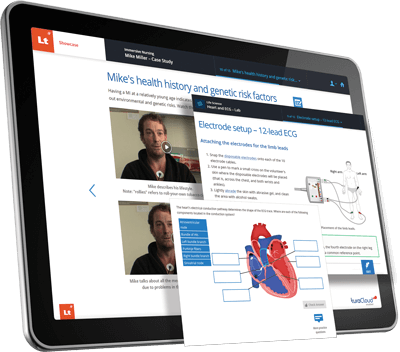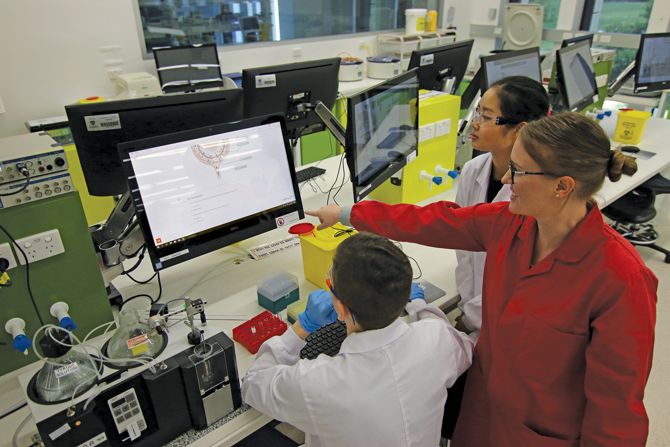Let’s face it - successfully running practicals in large teaching laboratories is challenging. Period.
There are so many aspects to coordinate: work health and safety specifications, laboratory equipment, bench space and consumables, computing technologies (plus all their connections), and then there's the students!

Tina Hinton, Associate Professor at the University of Sydney faces this challenge on a daily basis. As a medical science educator - she and her colleagues regularly teach and coordinate practicals for hundreds of undergraduate students at a time.
Their X- Lab at the Charles Perkins Centre also has the added feature of housing multiple units of study across multiple disciplines and cohorts. On any one day you will see many different practicals being conducted with different groups at the same time. So how do they do it?
We asked Tina to share her expert advice on how to make your labs run smoother - Check out her top 5 tips below!
1. Organization is key!
A well-organized online learning environment is just as important as a well-organized physical learning environment for truly effective hybrid learning. Well-authored practicals that guide students appropriately through the steps in their learning, coupled with a well-ordered physical environment, allows them to perform and to learn at their best.
We have all our learning requirements in one ‘go-to’ space to facilitate organization. Lt is our one-stop shop. Here, students work through their practical instructions step-by-step to collect, record, annotate and analyse their data. They also have the ability to upload images of their results and access additional links to Google docs, relevant internet pages and auxiliary analysis software tools. By ensuring students can access all their requirements from within one program, we can curate their experiences and help them navigate the requirements of their practicals in the time frames provided.

A well organized class, both online and in the laboratory, makes for far better learning outcomes. Student experience is optimized and you can feel satisfied with a job well done!
Related: 5 easy ways to create engaging lessons in Lt.
2. Don’t think that you can do it on the fly!
Here we are talking about the preparation before running practicals. It’s one thing to have carefully authored and organized your practical requirements in both the online and physical learning environments, but even a well-organized and well-intentioned practical can run awry if your team are not sufficiently prepped for the experience. Don’t think you can turn up and run your practical with the students cold!

We run ‘pre-practical’ sessions to help prepare our demonstrating team, and work out where any glitches might turn up or where instructions aren’t as clear as we’d hoped. In these sessions, we discuss the concepts and the procedures of the practical, to help our teaching teams understand the learning outcomes being taught, the pace of the practical, as well as the techniques required.
By providing demonstrators the opportunity to run through the practicals themselves from a student perspective, they can appreciate what the students will experience, preparing them for all the different possibilities (and potential problems!) that could arise during a practical.
3. Know your technical support peeps
No practical can run without the expert assistance of technical staff. To ensure our practicals run smoothly we have a great working relationship with our technical support team. We coordinate all our requirements for the practicals well in advance of the start of semester so they are familiar with our class sizes, equipment, software and resource needs, and any other aspects related to our practicals. Not only that, the technical support staff who will be setting up and helping run our practicals attend our pre-practical sessions so they are familiar with what the students need to do and how we would like the practicals to run.

We also ensure we have technical staff trained in Lt who are on hand to help with any connectivity or access issues that might arise during learn-time. Knowing your technical support team and working with them is an integral aspect to smooth-running laboratories.
Check out our Lt support section for helpful videos on using Lt
4. Know your ICT and never assume!
Good practicals and efficient teaching laboratories rely on the input and expertise of many teams around the University, including the Information and Communication Technologies (ICT) team. We have found that one of the secrets to ensuring a smoothly running laboratory is having an excellent working relationship with the relevant ICT team members tasked with the ICT requirements of our learning and teaching.
In tandem with our technical support team, we work with ICT to ensure all our laboratories are equipped with the hardware, software and access we need to ensure our students can learn. But once we have our requirements in place, we never assume everything will work just fine when we turn up on the day to teach! In today’s hybrid learning world, if the ICT isn’t working or available, the teaching cannot happen. So we make a point of checking all our hardware and software needs are available, accessible and ready to go before our classes. In this way we can avoid last minute panics and ensure our laboratories will run smoothly!
5. Prepare your students
One of the greatest advantages of hybrid learning is being able to prepare students for their practicals in advance of them arriving at the laboratory. For all our practicals we create ‘pre-work’. This requires students to work alone or in their small practical teams prior to the lab, so they are prepared in the theoretical concepts that will be explored during the practical, and familiar with the equipment and techniques that they will be using.

Lt provides the ultimate platform for this preparation as it seamlessly articulates with their in-class experience. Moreover, students can refer back to their pre-work while undertaking their practical. They can annotate and amend their notes as they wish during the learning process.
By implementing pre-work in Lt prior to our practical sessions, we have found students are able to appreciate the requirements of their practical work and understand why they are doing what they are doing, reinforcing their grasp of concepts and techniques for a better learning outcome.
Check out the short video below on how Lt has increased student learning and engagement in Tina's practicals. To see the full case study, click here.
More for life science educators:
Lt: Transforming the teaching of Medical Science
Lt: Time saving features for educators!
Five tips for teachers: How to activate you lessons!
Tips for educators: How to write multiple-choice questions

